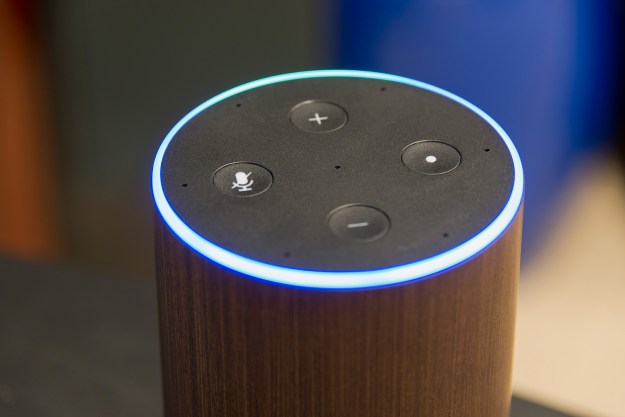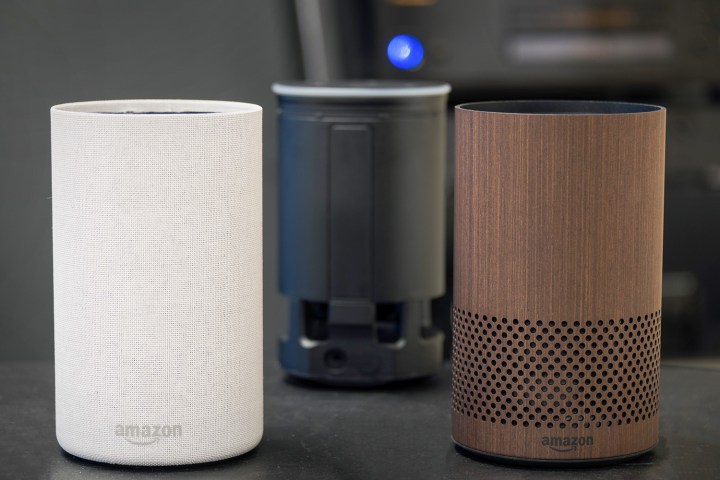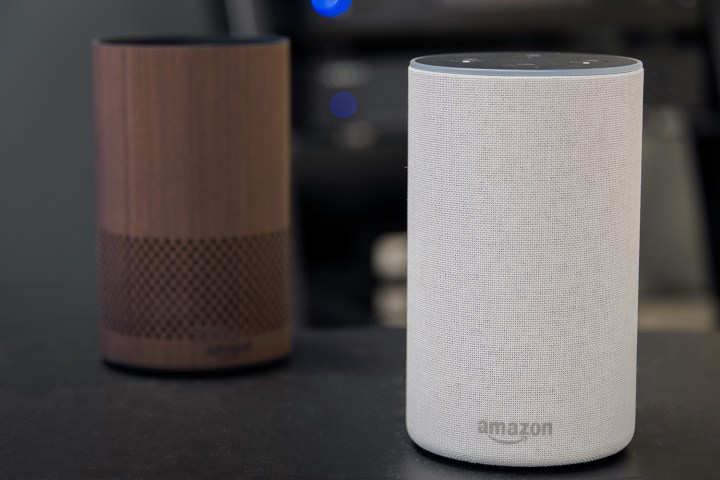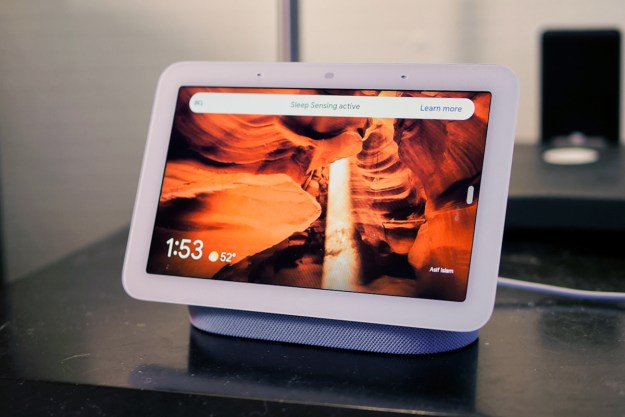
“The new Amazon Echo is cuter, smarter, and cheaper, and with a firmware update, now has improved acoustics.”
- Interchangeable shell allows you to mix up design
- Updated Alexa features include individual voice recognition and routines
- Compact
- Audio output Jack
- Sound on calling feature more muffled than with original Echo
- Acoustics better with firmware upgrade
When we published our original Amazon Echo review way back in November 2015, we were simultaneously creeped out and entranced with the strange new home assistant speaker featuring Alexa’s voice. We were uncertain about the device: Is this a quirky novelty or something that’s here to stay? The fact that we’re conducting another Amazon Echo review hints at the answer.
Looking back, you can’t really blame us. After all, it seemed so futuristic at the time: a device that you can tell to add toothpicks to your grocery list, turn off your lights, and play Disney songs for your kid? Weird, right?
Everyone seems to be scrambling to add Alexa’s skills and capabilities to their own devices
Little did anyone know how giant Alexa and the Echo would become. Instead of being creeped out by the voice assistant, everyone seems to be scrambling to add Alexa’s skills and capabilities to their own devices and products.
Now you’ll find various Echoes, including the Dot, Show, Plus, and Spot, and earlier this month, Amazon introduced updated versions of the Echo Dot, Show, and Plus as well as brand new speakers like the Echo Sub (stay tuned for full reviews on those devices). Other companies have followed with digital assistant speakers of their own, including Google Home, with the Mini and Max, and Apple with the HomePod.
But it is the original Echo that started the Alexa craze. We put it to the test against all the others to see if it still reigns supreme.
Out of the box and appearance: Smaller, cuter, and with more design options
The Echo box includes the speaker, a removable power adapter, and two small booklets — one with basic information on the Echo itself and the other with a tutorial on how to use Alexa.
The Echo 2.0 has four buttons – two for adjusting the volume up or down, one for action, and one to turn off the microphone. We appreciate the ability to adjust the sound with just the touch of a button rather than the original Echo’s dial-style volume control.
One of the key differences between the appearance of the original Echo and the 2.0 is the height and color. The original is a somewhat boring pillar-esque speaker – nothing you’d want to put on a table as a centerpiece. The new Echo is shorter in stature – just under six inches tall – and comes with more design choices and colors. When the old and new sit next to each other, the height difference is stark.
The new Echo is shorter in stature – just under six inches tall
With the new device, you can choose from various fabric styles and colors – charcoal, sandstone, and heather gray in fabric, oak or walnut veneer, or silver. We were surprised and pleased to find that the shells are interchangeable, so if you ever get tired of the sandstone color you bought, you can change it up with another texture or color. You can switch it out simply by pushing the device out of the shell using the thumb indentation on the bottom. Cost for new shells range from $30 to $30 on Amazon.
One problem we had with the original Echo was that fingerprint stains accumulated quickly and did not wash off. Our old Echo, which spent time in a kitchen, always looked dirty even when we wiped it clean. This should not be a problem with the fabric and wood veneer shells on the new Echo. Even if your child does accidentally smear their spaghetti-laden hands all over the shell, you don’t have to live with it. Just buy another one.
Set up
Attach the power adapter to the device on the back and plug into the wall. A blue ring of light around the top of the device will blink, and then Alexa will say:
“Hello, your Amazon Echo is ready for setup. Just follow the instructions in the Amazon Alexa app.”
If you haven’t already, you’ll need to download the Alexa app from the app store. Or if you prefer, you can set up your Echo via your browser. Once you’ve got the app, you should be guided through the setup process. If you don’t receive a prompt to do this, you can go to settings and then “set up a new device.” Once you do this, you’ll see an orange light circling the top of your Echo before hearing Alexa say, “You’ve connected to your Echo, go ahead and finish the set up in your Alexa app.”
You’ll be prompted to re-enter your Wi-Fi password, and then you’ll be given a short video tutorial on the Echo and Alexa’s capabilities. From the app, you can customize all kinds of things, including what you want included in your Flash Briefing or sports updates, and how to customize your device so that Alexa gives you personalized responses based on your voice.
While the voice-match feature for Google Assistant only asks you to repeat “Ok, Google,” and “Hey Google,” a couple of times, Alexa asks you to provide 10 specific requests, including things like “Alexa, add sugar packets to my shopping list” in order to recognize your voice. After you recite the requests, Alexa congrats you and then calls you by name. If you want to check her accuracy, you can ask her, “Alexa, who am I?” and she’ll give you the name of the person she thinks she’s talking to.
To connect with smart devices in your home, click on “smart home” in the menu bar in the app and you can add from there. This is also where you can add the new “groups” feature, which allows you to bundle certain devices with customized commands. So, for example, you can pair your living room lights with your front-door lock and say “Alexa, good night,” she’ll automatically turn off all of your lights and lock your door – no additional information necessary.
Testing, 1, 2, 3…
We set both the new Echo and the old Echo side by side to test out both response time and sound. With new hardware, we thought that perhaps the new Echo would respond to requests more quickly, but that wasn’t the case – they were about the same.
Alexa did a great job determining who was talking to her.
We tested out the calling feature on both the old Echo and the new one. For both tests, we called the same person and gave Alexa the phone number to call. We sat in the same location, and in both cases, there were people making noise in the background.
With the old Echo, the sound of both voices was clearer than with the new Echo. The person receiving the call noted that with the new Echo, the voice sound coming through appeared to be a bit more muffled. The background noise, however, was greatly reduced with the new Echo.
The voice recognition feature is more an Alexa software thing than an Echo thing, but because Amazon only recently rolled out the feature, we were eager to see how well it worked. Like Google Assistant, Alexa did a great job determining who was talking to her and adjusted her answers accordingly. What was even more interesting is that she gave one of our testers a response based not on a specific preference we’d outlined in the app, but on a question we’d asked her previously. Amazon’s claim that Alexa gets smarter the more she listens to you appears to be true.
Audio Performance
While the original Amazon Echo was an innovative new product when it was released in 2015, one thing that was definitely not innovative was the sound of the speaker. Our reviewer called the device “good enough” in sound quality. In other words, it worked for what it was designed to do, but don’t expect to blow your friends away with bass at your BBQ if you’re listening to music via the old Echo speaker.
The Echo 2.0 promised an improvement in sound quality over its predecessor, with a dedicated tweeter, a 2.5” down-firing woofer, and Dolby processing. Amazon says the improvements help the device to deliver crisper vocals and stronger bass throughout the room. Alexa integrates with Amazon Music, Pandora, Spotify, iHeartRadio, TuneIn and others, so you can play your playlists from just about anywhere. One key feature for your Spotify lovers is that you can now set Spotify as your primary music source in the app. It’s also compatible with several other streaming services, including Pandora and Deezer.
Our testers set both the original Echo and the new one next to each other in our home theater. When we first conducted the testing, we noted that the new Echo speaker actually took a dive in sound quality. The older Echo featured more prominent bass, a slightly more laid back midrange, and more muted treble. The new Echo had less bass and a slightly cleaner midrange, so vocals were a little less veiled in sound quality, but the treble, while more prominent, was a little on the dirty side.
Thank goodness for firmware updates, though. After hearing complaints about the sound from both customers and Digital Trends, Amazon pushed through a firmware update on the Alexa app that addressed several of our issues with acoustics. So, we decided to give the new Echo another listen.
What we found was that the firmware upgrade made a dramatic difference in the device’s sound quality. While the bass still wasn’t as robust as the original Echo, the sound of Bruno Mars’ Uptown Funk was less tinny and much crisper than in our original tests, with overall clearer acoustics than the original. The speaker also seems to enjoy a boost in overall gain, achieving higher sound pressure levels (volume) with less distortion.
The Echo isn’t designed to be an audiophile-grade speaker.
With that said, the Echo isn’t designed to be an audiophile-grade speaker — if that’s what you’re looking for, head straight for the Sonos One and never look back. We think for casual listening it will be fine for most folks. On the plus side, the new Echo adds an audio output jack, so if you really want to upgrade the sound, simply connect it to a full-blown audio system with an analog audio cable.
Alexa’s connections and skills
Now oodles of products, from smart speakers, thermostats, locks, and even light bulbs, have added the mighty Alexa to their functionality. In order to connect to them to Alexa, all you have to do is search for devices via the “add device” setting in your app. From there you can control them from anywhere in your home, assuming you’re within earshot of an Echo or Alexa-enabled speaker to direct her. The list of devices with Alexa capabilities are long and continue to grow every day. You can also connect Alexa to devices via third-party platforms like Wink.
Alexa now has more than 25,000 third-party skills that you can enable at last count, and companies are launching more daily.
Warranty information
There’s a one-year limited defects and materials warranty included, with the option to buy additional one-, two-, and three-year extended warranties for United States customers only.
Our Take
We’re glad the Echo is more affordable and more compact than before, but a little disappointed sound quality took a turn for the worse. Overall, the new Echo is more approachable and will likely be extremely popular.
Is there a better alternative?
Yes, while it is double the price, the Sonos One is a far superior-sounding speaker with the ability to use Alexa and, soon, Google Assistant. Within the same price range, though, there’s the Google Home featuring Google Assistant, although it does not connect with as many smart devices yet and does not have the long list of skills Alexa has. The Apple HomePod is another choice, but like the Google Home, is lighter on capabilities. If you’re just looking for an introduction to an Amazon Alexa speaker, consider the smaller and cheaper Echo Dot. It sounds pretty good and costs less at $50 (or even less when it’s on sale).
How long will it last?
It’s clear at this point that the Echo and Alexa platform is here to stay. Additional Alexa skills are being added daily, and Amazon does regular software updates, which means you’ll likely be supported for the long term.
Should you buy it?
Yes, if you are happy with the older Echo but are just looking to upgrade your hardware. If you’re looking for more out of your home assistant speaker, like, say a smart home hub, spend $50 more and buy the Echo Plus. If you want high quality sound, go for the Alexa-enabled Sonos One speaker.
Updated November 19, 2018 to note that Amazon now has newer devices available, including the Echo Dot 3.0, Echo Show 2.0, Echo Plus 2.0, and Echo Sub.
Editors' Recommendations
- The most common Echo Show problems and how to fix them
- How to use all Amazon Alexa alarm clock features
- Best Amazon Echo deals: Save on Pop, Show, Dot, and Studio
- The 6 best Echo Hub tips and tricks
- Echo Hub vs. Echo Show 8: Which is the best option for your smart home?








